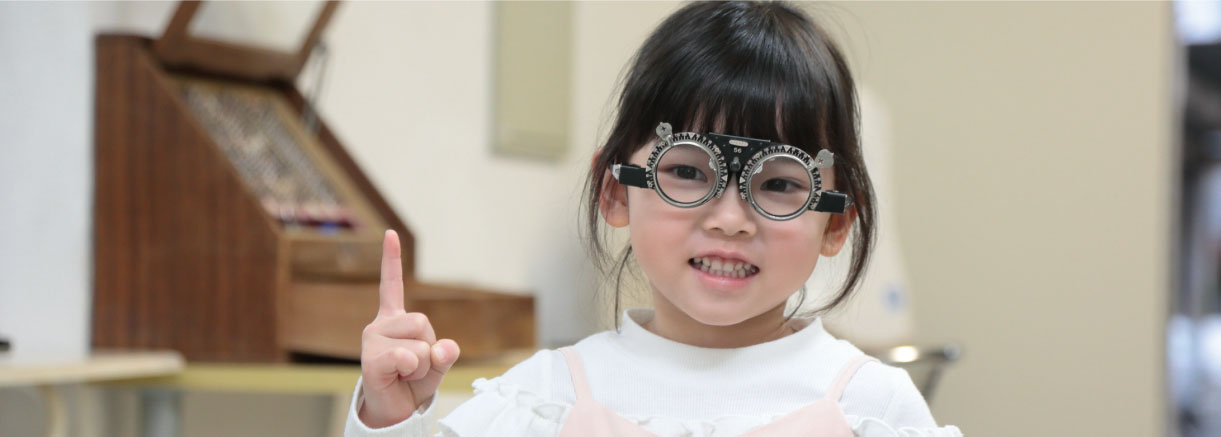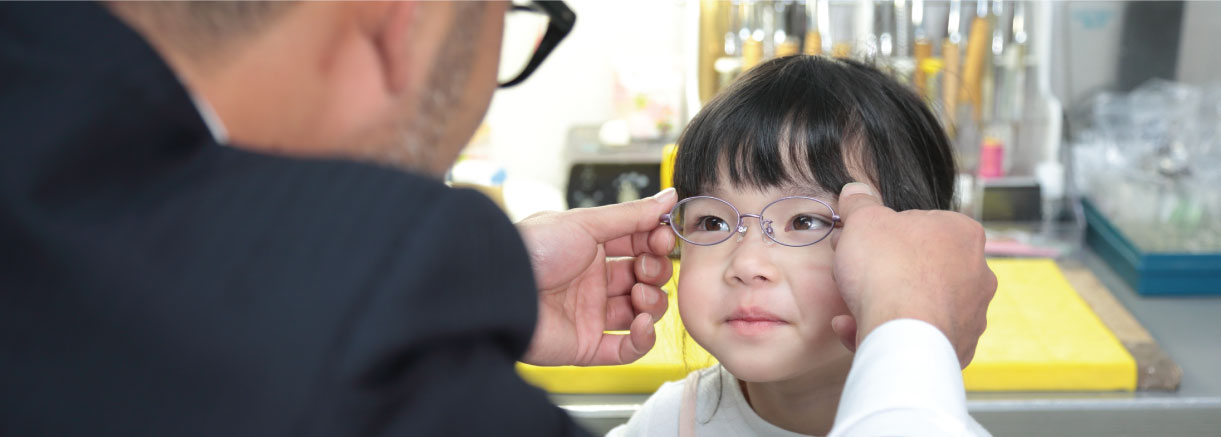

Prevent Missing Eye Abnormalities
- Detecting Concerning Behaviors -

Don't Miss Treatable Amblyopia Strabismus and amblyopia are often detected during the three-year-old health check-up, but early detection is crucial for better outcomes later.
Strabismus and amblyopia are often detected during the three-year-old health check-up, but early detection is crucial for better growth later on.
Taking small children to the ophthalmologist can be challenging, but if you notice any of the following behaviors, it is recommended to have them checked.
These behaviors are just examples, and each child may exhibit different behaviors.
For medical information, please refer to the website of the Japanese Ophthalmological Society.
Amblyopiahttp://www.nichigan.or.jp/public/disease/name.html?pdid=25
Children's Strabismushttp://www.nichigan.or.jp/public/disease/name.html?pdid=31
Children's Glasses
Help Growth
- For the Future of Children -
Continuing treatment helps children's eyes grow.
Amblyopia can be divided into medical amblyopia and social amblyopia. The former, medical amblyopia, is more common in children.
Here, we will focus on medical amblyopia.
Children's vision develops by seeing things every day.
By repeatedly receiving information through the eyes, the brain learns to process and understand it correctly. By around the age of six, children typically achieve vision similar to that of adults.
In contrast, amblyopia is a condition where vision development is halted or delayed due to some cause, resulting in insufficient vision.
Vision development can be expected with the use of corrective glasses or eye patches.
Strabismus is a condition where one eye is focused on an object, but the other eye is looking in a different direction.
Treatment aims to improve vision in both eyes and align the eyes correctly using glasses, fostering the ability to see with both eyes.
Continuing treatment consistently helps children's eyes grow.
There is a good possibility that glasses may no longer be needed, so it is important to continue proper treatment as much as possible.
How Often Should You Get Checked?
- Repeated eyeglass fittings Are Very Important -

- Repeated eyeglass fittings Are Very Important -
Children's vision can be difficult to measure depending on their physical condition or mood that day, making it hard to assess treatment progress.
However, it is extremely important to proceed slowly and consistently with treatment.
Lenses are changed according to the level of growth, and frames are adjusted to fit the growing face.
Since each child is different, consult with your primary care doctor and have regular check-ups that suit your child.
Jkids glasses are durable and resistant to damage, designed for repeated adjustments.
Message from Experts
- Important Things in Children's Eye Treatment -
Approximately 50 Years in Pediatric Ophthalmology
Osato Eye Clinic
Former Director, Dr. Sadako Tatsumi

Detect abnormalities in children's eyes
early during their developmental stage,
and quickly address them
to guide them back onto the
path of normal development. Early detection is key.
Since vision testing (ophthalmologic screening for three-year-olds) began as part of the three-year-old health check-up in 1991, I have truly felt that more children are visiting ophthalmologists at an earlier stage, which is a significant improvement.
Children's therapeutic glasses are intended to help the development of visual function by creating a clear image on the retina.
Therefore, it is crucial that the glasses are made according to the prescription, and next, that the fitting is appropriate.
Pay attention to whether the glasses are sitting correctly on the nose and not tilted.
Moreover, even if the glasses are made correctly, they are meaningless if the child refuses to wear them. I ask parents to be mindful of the color and pattern of the frame.
Before the glasses are ready, I recommend that parents who do not usually wear glasses put on a pair of inexpensive glasses from a 100-yen shop to show their child what it looks like.
Once the glasses are ready, choose a time when the child is in a good mood to start wearing them, saying things like "You're just like Daddy (Mommy), so cute!" to encourage them.

A Children's Glasses Specialty Store Selling About 100 Pairs Monthly
Melook Moji Store
Store Manager, Eisaku Kuwabara

Treatment is a Long-Term Process.
Choose Glasses That Can Accommodate
Children's Growth with Flexibility and Durability.
The key point in choosing children's glasses is whether they achieve a high level of both "functionality" and "design."
In the past, glasses prioritized functionality, resulting in sturdy but unattractive glasses (i.e., poor design).
Conversely, frames that have recently appeared on the market excel in design but fall short in durability and flexibility.
Children's movements are incredibly vigorous, and we have seen cases of damage that would be unimaginable for adults.
The glasses that put the least strain on a child's treatment are those that minimize the possibility of malfunctions or breakage and can withstand repeated adjustments.

Established in 1947, Delivering Glasses from Sabae
Orient Optical Co., Ltd.
President, Masaomi Umeda

Peace of Mind with Experience and Reliable After-Sales Service
in Designing and Manufacturing Children's Glasses.
The meaning of glasses for adults is completely different from that for children.
Children's glasses require high quality that can withstand intense activity and repeated adjustments. At the same time, we aim to improve the design and provide frames that excite children.
The quality of Sabae's domestic glasses is being highly valued once again. Experience the high quality of domestic frames and the excellence of metal frames that can withstand repeated adjustments at your local store.
(With low-priced stores dominating the market today, there has been a decline in the quality of products on display and the knowledge and skills of sales staff. Have you ever felt uneasy about factors other than price?
On the other hand, there are specialty stores with extensive knowledge and reliable after-sales service, where children and parents can feel assured.)
